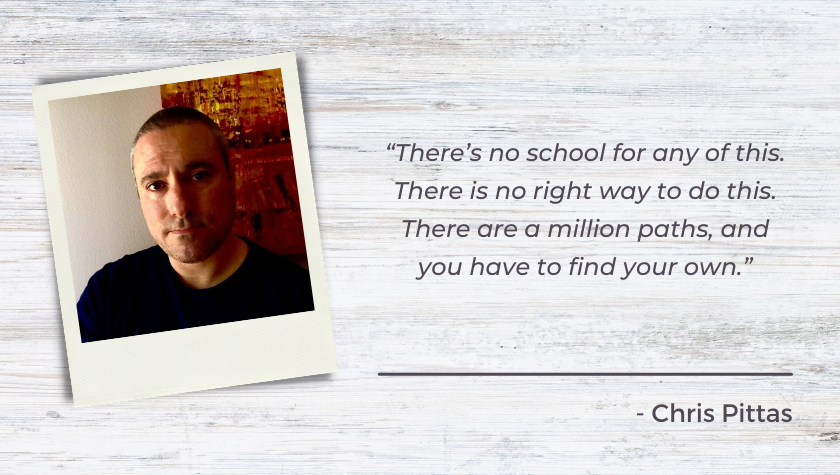The Screenwriter's Toolbox Part IV: Pitch Decks
October 26, 2021
Pitch Decks (Pitch Docs) can be an effective marketing tool that tells your script's story both visually and with text; because anything that gets your concept across in an easy-to-absorb fashion has value, right?
Plus, as an educator, they're even more valuable because they combine graphic arts, story concepts, visuals, and text — that’s truly a cornucopia of teachable techniques and classroom exercises all in one.
So, what is a pitch deck? Basically, a Powerpoint presentation. Good? Done. That’s all. Have a good week.
Yeah, so, it’s not quite that simple and there are some guidelines. So let’s cover them.
BUT IT IS BASICALLY A POWERPOINT PRESENTATION
When I do seminars, like many, I use Powerpoint (or Google Slides, OpenOffice Impress, Corel Presentations, Canva) to create slide-show presentations. The goal: To sell your audience on your particular viewpoint. In the case of a pitch deck, you’re attempting to get someone to want to consider your script.
Actually, to be more specific, pitch decks are used mostly to sell a potential production. In other words, you’re attempting to show visually and textually how your script could make a great feature (or TV series).
THE WHAT
A pitch deck is a carryover from the financial world’s prospectus. Investment opportunities have traditionally been accompanied by a slick presentation with numbers that are very favorable to the investor. They can be used for multiple types of opportunities, including fundraising, start-ups, real estate — the list is unlimited, which is how they also found their way into the film industry. An indie film can be an investment opportunity in many cases.
This goes to the heart of pitch decks. Either something is too complicated or too challenging for traditional markets, or you have a strong desire to take it indie to avoid the normal things that sometimes happen to a film in a studio system, including losing control of the material. In any case, a pitch deck conveys both visual excitement and story to pave the way for investors’ interest.
Complicated concepts, like The Matrix, benefited from visual presentations to accompany the storylines. The Wachowskis famously (apocryphally) created a graphic novel to get across the story and visual elements. A different form of pitch deck, but one nonetheless because of intent.
THE CATEGORIES
Alejandro Seri, Sr. Sales Director at Final Draft and a pro scriptwriter himself, had created a pitch deck for a feature he wrote. He felt as if the script would probably go over well in an indie market, so he created the presentation for it as an independent production.
We’ll follow Alejandro’s paradigm to show the various categories. You can take all these in total as a project for each student, or create teams and assign one category (and a script) to each and then pull them all together into a project.
A Final Draft template for pitch decks will be available soon, too.
1. Cover Art: "Show Don’t Tell" is one of those phrases that can never be said enough in film. Film and TV are visual mediums, so great cover art prompts another trope: A picture is worth a thousand words. Find or combine some images and a great layout to give that immediate visual impression. Sorta like a book cover.
2. Logline (w/images): A great logline has several elements that convey, in a brief form, the promise of the story (a concept we've covered in more detail here). To be effective it must include several elements. Let's refresh:
Combine the logline with another great image for max impact.
_____ (title) is a _____ (genre) about a___________ (description of flawed hero) who after ____________ (event that changes everything), wants to/must/struggles to (circle one) __________ (outer goal) by ________ (plan of action) before ____________ (dire things will happen). This becomes increasingly difficult because _________________ (obstacles & complications)
Sometimes, a thumbnail approach also works: It’s this meets this. Advise your students not to use bad films to compare — no one really wants two bad movies combined.
3. Overview: Some specifics about the script; keep them short and simple.
-
- Title: The Gardener
- Genre: Slasher horror
- Sub-Genre: Suspense
- Literary Themes: The grass isn’t always greener
- Cultural Themes: The exploitation of blue-collar labor
- Setting (time period): Present day
- Geographical Setting: A suburban neighborhood
- Action (what kind of action if any): Bloody and violent
- Rating: Hard PG-13/R
- Any more specifics about the script.
NOTE: The above was an example I put together. It has nothing to do with Alejandro’s drama script or pitch deck.
4. Synopsis: Synopses are great because they’re short. And a well-written one can be like an exciting short story. Images can be used, but make sure the text is readable. Busy people don’t like to get bogged down in minutia. Respect their time, and keep it to a page.
5. Movie themes: All stories have themes. Some are more involved than others, some can be as simple as Good vs. Evil. Keep it to a page.
Whereas theme is briefly covered in the Overview, this is the section you’d want to get into a little more depth, especially if your work is a drama like The Fault In Our Stars or Moonlight.
This might help fence-sitters who don’t think you’ve got enough depth in your presentation. Good themes are easy to recognize and resonant.
Joseph Campbell’s monomyth has been overused since the days of Star Wars but done properly (and lightly) it still has tremendous validity. Also, done properly, it’s a great way to teach.
6. Quotes: Some dialogue or narrative selections to give the reader a sense of the writing style. Comedies especially benefit from this. Again, keep it to a page.
For example, this quote from Airplane would have gotten a great response in a pitch deck, easily setting the tone while getting a reaction.
“Surely, you can’t be serious.”
“I am serious and don’t call me Shirley.”
Alejandro, on the other hand, is a philosophical and beautifully prosaic writer. He would include some of his narrative and some profound observations of the characters to give a sense of how beautiful the storyline is. Script excerpt:
"He finds Elena holding an exhausted Javier in her lap, his ribs wrapped in fresh gauze. The image looks like the Mexican version of an Annibale Carracci painting of Mary embracing Jesus at the foot of the cross."
7. Target Audience: This is a coin flip. It may not be necessary but if you are specifically targeting a demographic, then I’d include this.
Horror audience, Sci-Fi audience, Young Adult drama audience, adult drama audience…you get the idea.
8. Contact: Duh. How to get in touch. If it was me, I’d put this in several (unobtrusive) places and one very obtrusive place — like this contact slide.
Optional: Some other categories that might be needed to pitch a production proposal. Not so much if it’s just a script:
-
- Budget
- The Mission
- Production Team
- Distribution
- Festival Strategy
- Cast/Crew Wish List
I’ve also seen a section in some pitch decks called a Mood Panel. These are perhaps standalone images that give you a sense of the overall feel of the script/movie.
Also, don’t be shy about including press clippings, any contest/festival wins, and some letters of recommendation from reputable sources like agents, producers, studio execs, contest directors, etc. either about yourself or your team members.
Can you see how doing a pitch deck as a class project could be tremendously helpful? Either as teams or individuals, so many elements contribute to the presentation that it would be great fun and so teachable.
TOOLS
As mentioned, there’re a ton of tools you can use to create a pitch deck including the big dog, Powerpoint.
Almost anything that allows a linear presentation, like slides, will work. Canva seems to be making some noises in this direction as a current fav, but as I’ve said, almost any presentation software on the planet is going to be fine for this.
I like Powerpoint a lot. It’s a feature-rich, easy-to-use piece of software and it does more than anything I’ll ever need. Should you add music? Videos? Why not? As long as it’s not too intrusive. Powerpoint will do both.
Earlier I mentioned some alternatives to Powerpoint. Google Slides, OpenOffice Impress, Corel Presentations, Canva all do the job. Google slides has the advantage of being cloud-based and operating system agnostic. In other words, Mac, PC, Linux — doesn’t matter. Since you access it via a browser, it will (should) work on all those OS platforms.
One more point: you can purchase Powerpoint templates for pitch decks from various entities. Most of these aren’t film-specific, but they’ll do until Final Draft’s template drops.
As an instructor, giving your students a solid example (or filling in a template with them) can be quite valuable as guidance.
CONCLUSION
The old saying about learning by mistakes has defined my life. By now, I should be genius-level in everything I do. My flippancy has a point. There’s a lot of ways to do any project that involves creativity. Pitch decks are certainly in that category.
If I was teaching this, especially to younger students, I’d give them the basics and set them free without too much instruction. Let them make their own mistakes, try different things out. The critiquing of these pitch decks is as instructional, maybe even more so, as anything you’ll do. Plus, you’re going to see creativity unleashed, some good, some not so good, but certainly all well-intentioned and fun.
Let your students push in on their creativity without too many expectations. After all, we can all be pleasantly surprised by the results of something unexpected. I see pitch decks as probably the most comprehensive interactive project you can do short of making a film. It involves everything you’re teaching and more. Pitch decks are the new collages for classrooms. Your students can thrive and create something they can show to the world. What more can you ask for of a teachable moment?
Written by: Mark Sevi
Mark Sevi is a professional screenwriter, screenwriting teacher, and podcaster. He is the founder of the Orange County Screenwriters Association.- Topics:
- Industry Interviews & Spotlights




